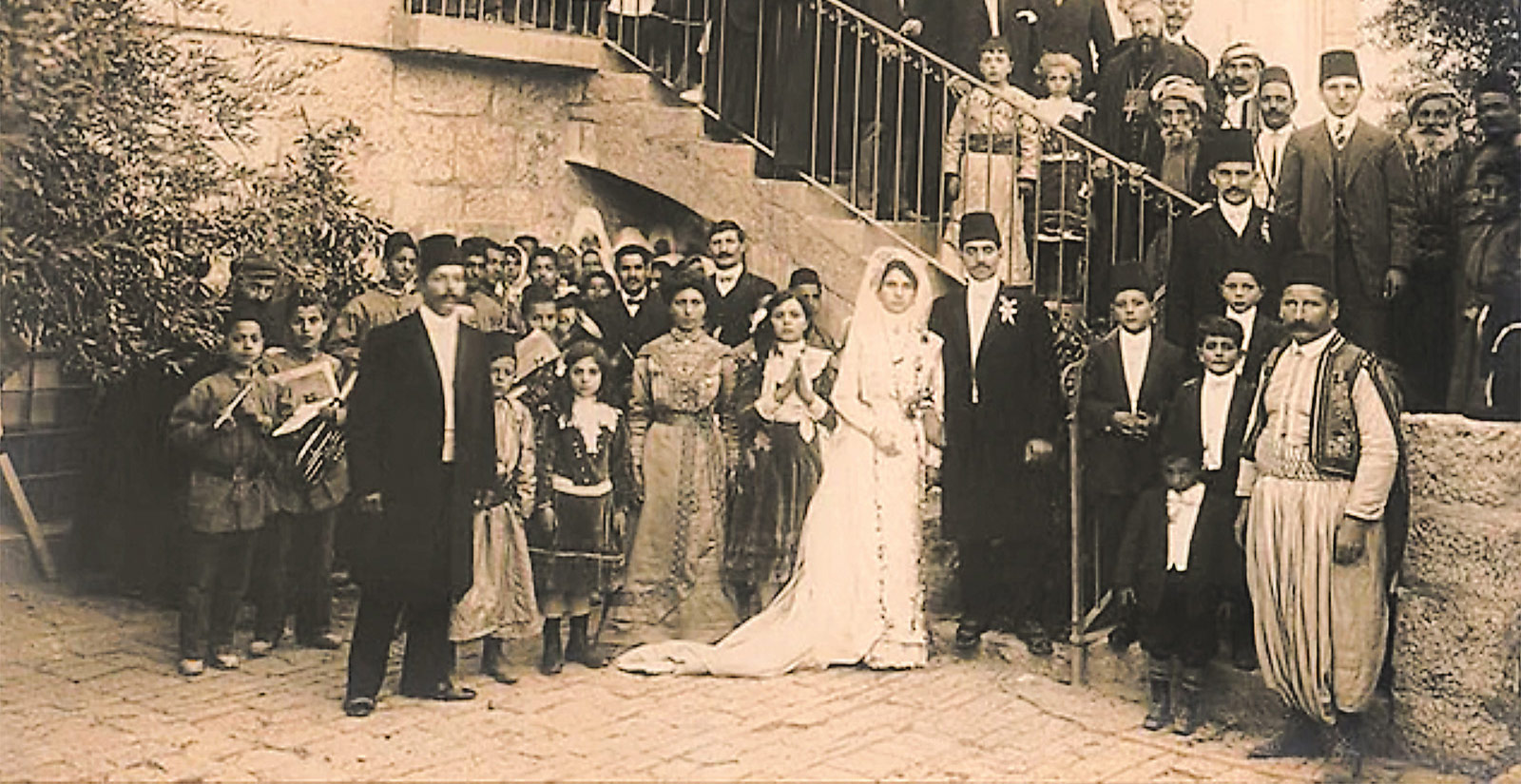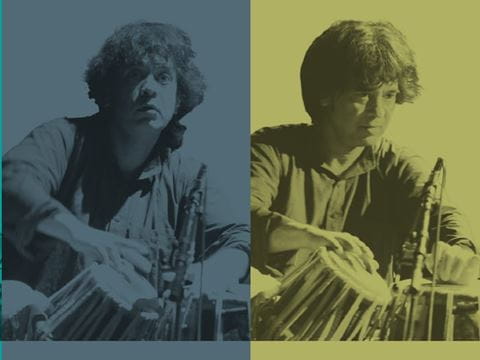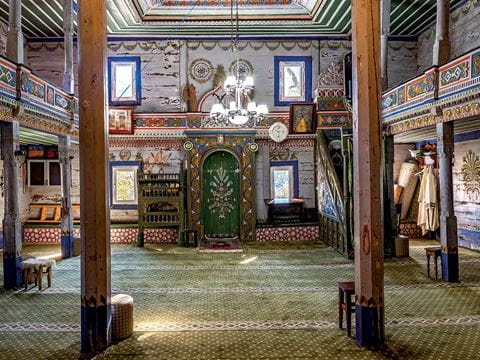
The Arts Come Home to Bethlehem
From urban gardening workshops to artists in residence, gallery shows, cinema and a historical archive, Dar Jacir is one of the oldest and most stately homes in Bethlehem and one of the Palestinian town’s newest touchstones for creative expressions.
Scattered across an expansive outdoor stone patio, family members embrace and art connoisseurs gather shoulder to shoulder with a beaming Yusuf Nasri Jacir. The 83-year-old’s adult daughters, Emily and Annemarie Jacir, and some 200 supporters, beneficiaries and children from a Bethlehem-area refugee camp reflect his pride in celebrating the reopening of the Jacir family home.
Seeing the garden alight with conversing guests and children cutting capers across the courtyard, running past the thick-trunked pine trees and the home’s original 19th century stone walls, marks a fulfillment of a lifelong dream. The launch of Dar Yusuf Nasri Jacir for Art and Research culminates more than a decade of work he began with his daughters to keep the home running and standing under the guardianship of his family.

The house, he says, “has seen much happiness and much turmoil. I’m very pleased that it is full of people, of children, and art and positive energy,” adding how delighted he is to see the house experiencing new life after years of disrepair.
At various times in decades past, hoteliers offered top dollar to turn the house into a trendy boutique hotel and restaurant. But Jacir’s late father, Nasri Jacir, a modestly paid journalist and Arabic language teacher, spent every dollar he had to keep the estate in the family even when he could not afford maintenance. In the late ’90s, Jacir bought the family shares from his siblings and became the owner and custodian of the property, pouring his savings into upkeep.
A few years ago, when Jacir’s daughters began envisioning an art space for the community, Jacir realized they could preserve the estate for future generations that way. Restoration plans in 2014 led to renovations in 2017 while artists, writers, filmmakers and landscape artists were already in residence.
“This is a space where people gather and can ask questions, make mistakes and exchange ideas,” says Emily Jacir, 47, an acclaimed artist who uses film among other media in her work. As director and cofounder of Dar Jacir, she has brought her experience as both an artist and a teacher to all those who come through the door. “Education, experimentation and research have always been key to my practice as an artist, and I consider them essential components to this project.”

Entering Dar Jacir’s wrought iron gates is a fragrant experience: sage, thyme and mint perfume the terrace enclosure. A copper sign reads in Arabic: “Dar Yusuf Nasri Jacir for Art and Research.” (Dar is Arabic for home.) The name is especially fitting, as the Jacir family has been linked with the two-story limestone house on Hebron (al-Khalil) Road since Emily and Annemarie’s great-great-grandfather, Yusuf Ibrahim Jacir, laid its first stone in the soil in 1888.
Dar Jacir was one of the first homes built at the main entrance of Bethlehem, and it marked the historic expansion of the city’s boundaries. In the home’s early days, the family members were merchants who traded worldwide in—among other goods—the famous Bethlehem craft of mother-of-pearl inlay. When renovations began for Dar Jacir, Emily uncovered historical documents from her ancestors in the basement, including 19th-century business letterheads displaying addresses in Bethlehem, Beirut, Paris and Barranquilla, Colombia—all indicators of the reach of her family’s trade in the early days of the home. Jacir’s great-grandfather, Yusuf Ibrahim, who was also responsible for the town population registry in the late 1800s, had kept all his documents in the home. She also found early photographs, letters and other correspondences. Together, these records are now the Jacir Ottoman Archive, housed on site for study and preservation.
Nearly 140 years after the home was built, it continues to be a place where work and discovery meet. With Emily, Annemarie Jacir, 43, also serves as a cofounder of the space. Both have been inspired by the home since childhood, long before becoming successful artists and filmmakers. They understand, they say, the appeal of the home, and why it has become special to fellow artists.
“I spent months painting and sketching this house, the landscape, things which grew in the earth and the people in the house,” Emily says, remembering that when she first began to paint and draw, she looked to Dar Jacir for inspiration. “My feet are grounded here, in this house and on these stones, for as long as I can remember.”


Today, Dar Jacir offers a unique space in the Bethlehem area, with its two-meter ceilings and generous exhibition room. There is also a film-viewing hall and a schedule of educational programs teaching, among other subjects, urban farming. Most of the center’s programming is geared toward youth.
For Emily—a 2007 Prince Claus Award laureate and recipient of honors including the Golden Lion at the 52nd Venice Biennale and The Herb Alpert Award for the Arts—opening Dar Jacir for young and emerging artists was an essential contribution to Bethlehem.
Annemarie, a filmmaker and poet, also views restoring Dar Jacir as a passion project. She is a founder of the Palestinian Filmmakers’ Collective and member of the Academy of Motion Picture Arts and Sciences, which awards the Oscars. She understands the struggles many artists experience in finding the support, environment and tools with which they can flourish. The sisters have shared the vision of reimagining the home if only so that future generations of artists have a richer experience and fewer barriers.

Since programming first began in 2017, children from the nearby Aida Camp, home to more than 5,000 refugees, have been regular participants. They come to watch films and learn about local plants and participate in urban gardening projects. Mohammad Saleh, 34, an agricultural engineer and urban gardening expert, leads the program as one of his tasks as a resident instructor.
“There are no more green spaces left in Bethlehem since the city was cut off from most of its agricultural land by the wall,” Annemarie says, referring to the barrier near the home that often leads residents and agricultural experts to ponder food security solutions for the region.
Urban gardening, she says, can be useful as well as inspiring, innovative, beautiful and soothing—which means it fits right in with other art expressions taking shape at Dar Jacir. For all of these reasons, she says, “the art of urban gardening has taken on a new urgency.”
When visitors arrive at Dar Jacir, many take a few moments and tour the spaces on the lower floor, where they can admire photographs on the walls and investigate some of the many spaces in the home and its open gardens before participating in programs.

Some of the photos show the Jacir family through decades as far back as the late 19th century. Other photos are recent and contemporary artworks, showing wheat and seeds, photographed by Palestinian filmmaker Jumana Manna, whose work often deals with food security. There are also modern olive-wood sculptures sitting atop floors of hand-painted tiles. Traditionally, Bethlehemites carved olive-wood sculptures, and today, contemporary craftspeople and artists are reinterpreting themes with the same olive wood.
For local sculptor Ayed Arafeh, Dar Jacir offers the right environment for creativity.
“For me, producing at Dar Jacir was a different atmosphere from sculpting in my own studio,” he says, referring to the home’s serenity, architecture and soft lighting that filters through colored glass above the windows and doors. “It provided the quietness and isolation needed for artistic production.”

One of Dar Jacir’s central arts offerings is its residency program, which began more than a year before the inaugural celebration in 2019. It was conceived for artists to lead their own work and teaching efforts. Manna, whose 2017 film Wild Relatives explores how taxonomies of cultivating seeds and plants have contributed to colonialism, is one such resident. So, too, is us multimedia and graffiti artist Sam Durant, who left a literal mark on the home with his illuminated Arabic sign art placed on the roof. It read: “The food is at Dar Jacir.” The sign was visible for kilometers, and it refers to an early 20th century Bethlehem saying lauding Dar Jacir for providing food to the needy.
“It is always important to be present in a place, especially one as important as Palestine. My experience there will certainly influence my work going forward,” Durant says.
Dar Jacir also served as a temporary home for Duncan Campbell of Glasgow, who in 2014 won the prestigious Turner Prize. Campbell has shown and shot film projects on location at Dar Jacir during his residency and describes his work as renditions of “how the story of real events are told, in the reliability and unreliability of these stories.”
In the Jacir Ottoman Archive, each item is now being read and analyzed by both Emily and Mounir Fakhreddin, a professor of Ottoman and British history in Palestine. Fakhreddin has determined the historic value of the collection of tens of thousands of photos, newspaper clippings, financial records, letters and other items from about 1860 to 1950, written in Arabic, Ottoman, Spanish, French and Italian. Many are still being restored and cataloged from the dozens of unopened boxes that were stored in the home for decades gathering dust.
“The history of this family, as reflected in its archive, tells us about local, regional and global connections in a very particular period of world and Levant history,” Fakhreddin says. “Studying the archives of Levant families like Dar Jacir will shed new light on world historiography, local Palestinian history and help put the diaspora into better context.”

Since the collection is one of the few from the late Ottoman period with an extensive and continuous record of finances and minute details of daily life, Emily notes the collection’s value for scholars around the world who study the historical relationships between Bethlehem and cities in South America, France and Lebanon.
“The collection shows how ideas, people and goods moved and lived across continents,” she says.
One of the critical aims of the home, Emily Jacir says, is to also engage diaspora Palestinians with roots in the Bethlehem region and encourage them to return to the city and use Dar Jacir.
“It helps artists produce work in Palestine and, hopefully in the process, reflect on Palestine,” says Emily.
You may also be interested in...

Zakir Hussain Played Tabla in Indian Classical Music and Beyond
Arts
While mastery of Indian musical traditions is one clear accomplishment, the late Zakir Hussain’s bold pursuit of his art across genres likely best defines his legacy.
FirstLook: Poetic Fusion
Arts
Prior to our modern practice of image manipulation with editing software, photographers worked more with planned intention and craft.
Restoration Uncovers Beauty of Georgia’s Hidden Wooden Mosques
Arts
Until recently few outsiders knew the wooden mosques dotting the highlands of Georgia existed, leaving many of them to deteriorate. The rediscovery of the architectural gems has sparked a movement for their preservation.